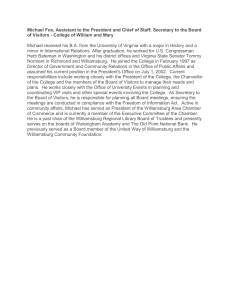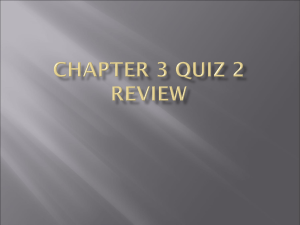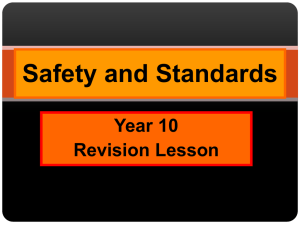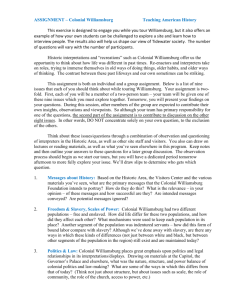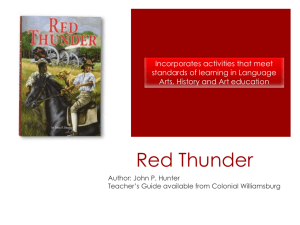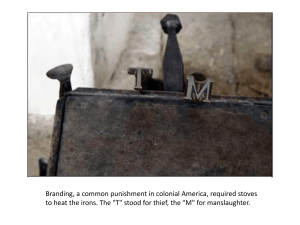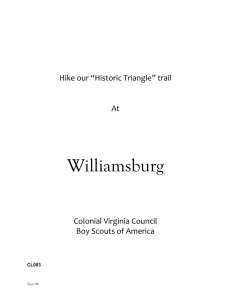Presentation Outline - California Society of the Sons of the American
advertisement
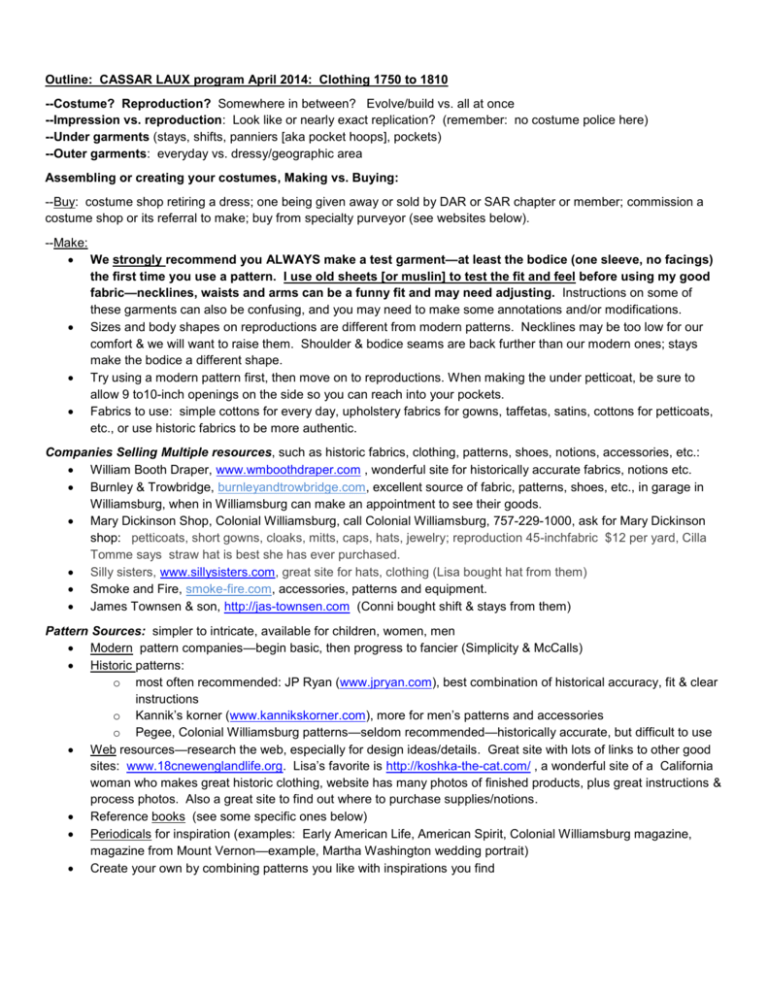
Outline: CASSAR LAUX program April 2014: Clothing 1750 to 1810 --Costume? Reproduction? Somewhere in between? Evolve/build vs. all at once --Impression vs. reproduction: Look like or nearly exact replication? (remember: no costume police here) --Under garments (stays, shifts, panniers [aka pocket hoops], pockets) --Outer garments: everyday vs. dressy/geographic area Assembling or creating your costumes, Making vs. Buying: --Buy: costume shop retiring a dress; one being given away or sold by DAR or SAR chapter or member; commission a costume shop or its referral to make; buy from specialty purveyor (see websites below). --Make: We strongly recommend you ALWAYS make a test garment—at least the bodice (one sleeve, no facings) the first time you use a pattern. I use old sheets [or muslin] to test the fit and feel before using my good fabric—necklines, waists and arms can be a funny fit and may need adjusting. Instructions on some of these garments can also be confusing, and you may need to make some annotations and/or modifications. Sizes and body shapes on reproductions are different from modern patterns. Necklines may be too low for our comfort & we will want to raise them. Shoulder & bodice seams are back further than our modern ones; stays make the bodice a different shape. Try using a modern pattern first, then move on to reproductions. When making the under petticoat, be sure to allow 9 to10-inch openings on the side so you can reach into your pockets. Fabrics to use: simple cottons for every day, upholstery fabrics for gowns, taffetas, satins, cottons for petticoats, etc., or use historic fabrics to be more authentic. Companies Selling Multiple resources, such as historic fabrics, clothing, patterns, shoes, notions, accessories, etc.: William Booth Draper, www.wmboothdraper.com , wonderful site for historically accurate fabrics, notions etc. Burnley & Trowbridge, burnleyandtrowbridge.com, excellent source of fabric, patterns, shoes, etc., in garage in Williamsburg, when in Williamsburg can make an appointment to see their goods. Mary Dickinson Shop, Colonial Williamsburg, call Colonial Williamsburg, 757-229-1000, ask for Mary Dickinson shop: petticoats, short gowns, cloaks, mitts, caps, hats, jewelry; reproduction 45-inchfabric $12 per yard, Cilla Tomme says straw hat is best she has ever purchased. Silly sisters, www.sillysisters.com, great site for hats, clothing (Lisa bought hat from them) Smoke and Fire, smoke-fire.com, accessories, patterns and equipment. James Townsen & son, http://jas-townsen.com (Conni bought shift & stays from them) Pattern Sources: simpler to intricate, available for children, women, men Modern pattern companies—begin basic, then progress to fancier (Simplicity & McCalls) Historic patterns: o most often recommended: JP Ryan (www.jpryan.com), best combination of historical accuracy, fit & clear instructions o Kannik’s korner (www.kannikskorner.com), more for men’s patterns and accessories o Pegee, Colonial Williamsburg patterns—seldom recommended—historically accurate, but difficult to use Web resources—research the web, especially for design ideas/details. Great site with lots of links to other good sites: www.18cnewenglandlife.org. Lisa’s favorite is http://koshka-the-cat.com/ , a wonderful site of a California woman who makes great historic clothing, website has many photos of finished products, plus great instructions & process photos. Also a great site to find out where to purchase supplies/notions. Reference books (see some specific ones below) Periodicals for inspiration (examples: Early American Life, American Spirit, Colonial Williamsburg magazine, magazine from Mount Vernon—example, Martha Washington wedding portrait) Create your own by combining patterns you like with inspirations you find Accessories: Hats/bonnets/caps (koshka-the-cat.com has instructions on how to cover a hat). “gloves”/mittens Capes /cloaks Shoes—fugawee.com; 800-605-8280 Scarf (handkerchief)/lace for the décolletage area abrahamslady.com has Civil War some accessories that work for our era, e.g., glove, hankies, hat pins, fans, etc.). Fabrics: Historically accurate will probably be linen, wool, or cotton, costumes may use any fabrics. We have bought most of our costume fabrics at upholstery/decorating fabric stores or areas of stores (esp. discount/clearance) Reference Books and where to buy them: Colonial Williamsburg publications: (1) Costume Close-Up, Clothing Construction and Pattern 1750-1790 (1999)—contains wonderful photos of clothing in the Williamsburg collection, and scaled-down patterns which can be enlarged and used to construct items (used from $9.00, new $20.52, Amazon); (2) What Clothes Reveal, the Language of Clothing in Colonial and Federal America (2002 & 2011)—contains fabulous photos and descriptions to be used for inspiration (used from $22, new paperback $30, Amazon). NSSAR merchandise department—Women’s Dress During the American Revolution, An Interpretive Guide, produced by Brigade of the American Revolution, $25—really helpful to understanding clothing and construction techniques—historically accurate for reproducing. Book: Whatever Shall I Wear? A Guide to Assembling a Woman’s Basic 18th Century Wardrobe --Excellent reference on clothing of the period, recommended by Cilla Tomme (I purchased at Guilford Courthouse national military park, available on Amazon for about $11.00) . Booklet: Clothing for Ladies and Gentlemen of Higher and Lower Standing, purchased by Cyndy Bigbee at Minute Man National Historical Park. Book: Tidings from the 18th Century, Colonial American How-To and Living History (1993)—($23.83 softcover Amazon) recommended to Conni by a reenactor, contains detailed information on accessories, sewing techniques, clothing for women, children and men, and details on running households in the period, even making and serving tea, coffee and hot chocolate! Patterns of Fashion, Englishwomen’s dresses and their construction, Vol. 1, c. 1660-1860, by Janet Arnold. Great used book website: www.abebooks.com Getting started: Making a simple mobcap: Cut 2 large circles (about 22 inches diameter, larger or smaller depending on the size of your head and hair). Sew the circles right sides together, ¼ inch seam, leaving 3 to 4 inches open. Clip seam and press. Turn right side out. Add lace to the outside if you wish. 1 ½ to 2 inches from the outside, sew 2 seams to make a channel to run elastic or drawstring through. Insert elastic or drawstring to fit. Making a simple petticoat: Use about 2 yards of fabric, (45 inch OK if no panniers, 54 inch wide if using panniers), cut about 4 inches off one end for the waistband. Cut remaining fabric in half crosswise. Sew 2 side seams, leaving a 9 to10inch opening at the top of each seam. Create waistband, allowing for several inch overlap on the ends. Gather or pleat (I prefer pleats) skirt and sew into the waistband. Put fasteners on waistband (I use button or cheat with Velcro). Hem. To make a reproduction petticoat, go to instructions at http://www.koshka-the-cat.com/18c_petticoat.html (Lisa used). Questions or to share your ideas: Call or e-mail one of us. Conni Barker: 530-205-9581; conniL1970@comcast.net Lisa Gregory: 562-493-6409; paylisa@earthlink.net To see and handle: patterns, books, mop caps, Williamsburg bonnets, lace cap, mittens, all dresses, all undergarments, cloak, cape, hats.. TAKE: my dress dummy, computer and flat screen
